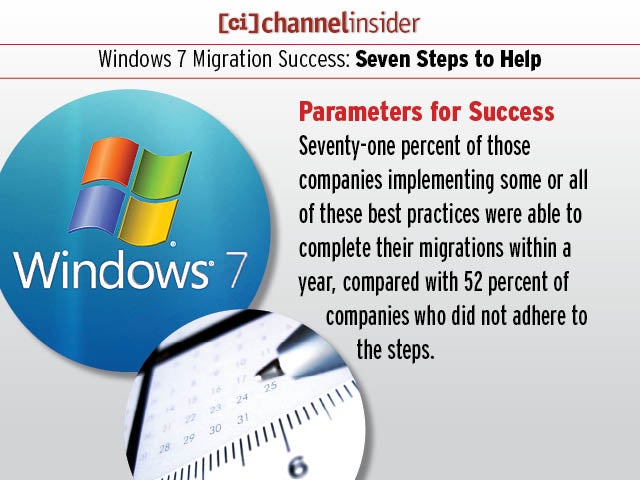 Windows 7 Migration Success Seven Steps to Help
Windows 7 Migration Success Seven Steps to Help
Parameters for SuccessSeventy-one percent of those companies implementing some or all of these best practices were able to complete their migrations within a year, compared with 52 percent of companies who did not adhere to the steps.
 No Title
No Title
Parameters for SuccessCompanies who leveraged these best practices were only offline a median of two hours, compared to six hours for the bottom-tier organizations.
 No Title
No Title
Parameters for SuccessAmong the best performing companies who held the following steps important, 60 percent of end users reported they were extremely satisfied with the migration, compared to just 25 percent of end users at the underperforming companies.
 No Title
No Title
Step 1: Advanced PlanningTop tier companies who experienced less downtime and faster migration say they dedicated double the IT man hours than those companies that struggled, with an average of 20 IT man hours being spent by these higher performing companies.
 No Title
No Title
Step 2: Upgrading HardwareApproximately 44 percent of all respondents reported that hardware issues were one of the most common obstacles that caused migration delays. Most respondents agreed that a minimum of a 2 to 2.5 GHz processor, 2 GB of RAM, 200 to 500 GB of hard drive space and a 512 MB video card smoothed the migration path.
 No Title
No Title
Step 3: Application TestingEven more troubling than hardware issues were application problems. Fifty-three percent of respondents reported that application incompatibility caused the biggest delays during migration. Testing of key applications before roll-out is a vital step.
 No Title
No Title
Step 4: Application VirtualizationSome organizations chose to replace or upgrade applications for compatibility, but that’s not always an option. The survey showed that 69 percent of IT leaders believe that application virtualization is an effective workaround to the problem of incompatibility.
 No Title
No Title
Step 5: Pilot TestsDon’t just roll out everything all at once. After you’ve tested applications, start with a small cadre of users to work out the deployment kinks. Forty-five percent of successful migrators rate pilot testing as a crucial step in the process.
 No Title
No Title
Step 6: Automate Roll-OutFifty-four percent of all respondents automated the actual roll-out of system upgrades and the average respondent reported that an organization with 10 or more PCs would do well to invest in automation technology.
 No Title
No Title
Step 7: User TrainingNearly double the percent of top performers placed an emphasis on end user training compared to those who struggled.

